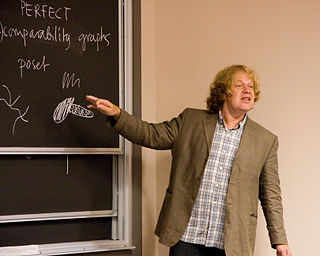Computational geometry is a branch of computer science devoted to the study of algorithms which can be stated in terms of geometry. Some purely geometrical problems arise out of the study of computational geometric algorithms, and such problems are also considered to be part of computational geometry. While modern computational geometry is a recent development, it is one of the oldest fields of computing with a history stretching back to antiquity.

Theoretical computer science is a subfield of computer science and mathematics that focuses on the abstract and mathematical foundations of computation.

Mesh generation is the practice of creating a mesh, a subdivision of a continuous geometric space into discrete geometric and topological cells. Often these cells form a simplicial complex. Usually the cells partition the geometric input domain. Mesh cells are used as discrete local approximations of the larger domain. Meshes are created by computer algorithms, often with human guidance through a GUI, depending on the complexity of the domain and the type of mesh desired. A typical goal is to create a mesh that accurately captures the input domain geometry, with high-quality (well-shaped) cells, and without so many cells as to make subsequent calculations intractable. The mesh should also be fine in areas that are important for the subsequent calculations.

David Arthur Eppstein is an American computer scientist and mathematician. He is a distinguished professor of computer science at the University of California, Irvine. He is known for his work in computational geometry, graph algorithms, and recreational mathematics. In 2011, he was named an ACM Fellow.
Jock D. Mackinlay is an American information visualization expert and Vice President of Research and Design at Tableau Software. With Stuart Card, George G. Robertson and others he invented a number of information visualization techniques.

Lawrence Jay Rosenblum is an American mathematician, and Program Director for Graphics and Visualization at the National Science Foundation.

Computer graphics is a sub-field of computer science which studies methods for digitally synthesizing and manipulating visual content. Although the term often refers to the study of three-dimensional computer graphics, it also encompasses two-dimensional graphics and image processing.
Brian A. Barsky is a professor at the University of California, Berkeley, working in computer graphics and geometric modeling as well as in optometry and vision science. He is a Professor of Computer Science and Vision Science and an Affiliate Professor of Optometry. He is also a member of the Joint Graduate Group in Bioengineering, an inter-campus program, between UC Berkeley and UC San Francisco.

János Pach is a mathematician and computer scientist working in the fields of combinatorics and discrete and computational geometry.

Kenneth Lee Clarkson is an American computer scientist known for his research in computational geometry. He is a researcher at the IBM Almaden Research Center, and co-editor-in-chief of Discrete and Computational Geometry and of the Journal of Computational Geometry.
Roberto Tamassia is an American Italian computer scientist, the Plastech Professor of Computer Science at Brown University, and served as the chair of the Brown Computer Science department from 2007 to 2014. His research specialty is in the design and analysis of algorithms for graph drawing, computational geometry, and computer security; he is also the author of several textbooks.
Informatics is the study of computational systems. According to the ACM Europe Council and Informatics Europe, informatics is synonymous with computer science and computing as a profession, in which the central notion is transformation of information. In some cases, the term "informatics" may also be used with different meanings, e.g. in the context of social computing, or in context of library science.
Ming C. Lin is an American computer scientist and a Barry Mersky and Capital One Endowed Professor at the University of Maryland, College Park, where she is also the former chair of the Department of Computer Science. Prior to moving to Maryland in 2018, Lin was the John R. & Louise S. Parker Distinguished Professor of Computer Science at the University of North Carolina at Chapel Hill.

Joseph S. B. Mitchell is an American computer scientist and mathematician. He is Distinguished Professor and Department Chair of Applied Mathematics and Statistics and Research Professor of Computer Science at Stony Brook University.
Visual computing is a generic term for all computer science disciplines dealing with the 3D modeling of graphical requirements, for which extenuates to all disciplines of the Computational Sciences. While this is directly relevant to the software visualistics of Microservices, Visual Computing also includes the specializations of the subfields that are called Computer Graphics, Image Processing, Visualization, Computer Vision, Computational Imaging, Augmented Reality, and Video Processing, upon which extenuates into Design Computation. Visual computing also includes aspects of Pattern Recognition, Human-Computer Interaction, Machine Learning, Robotics, Computer Simulation, Steganography, Security Visualization, Spatial Analysis, Computational Visualistics, and Computational Creativity. The core challenges are the acquisition, processing, analysis and rendering of visual information. Application areas include industrial quality control, medical image processing and visualization, surveying, multimedia systems, virtual heritage, special effects in movies and television, and ultimately computer games, which is central towards the visual models of User Experience Design. Conclusively, this includes the extenuations of large language models (LLM) that are in Generative Artificial Intelligence for developing research around the simulations of scientific instruments in the Computational Sciences. This is especially the case with the research simulations that are between Embodied Agents and Generative Artificial Intelligence that is designed for Visual Computation. Therefore, this field also extenuates into the diversity of scientific requirements that are addressed through the visualized technologies of interconnected research in the Computational Sciences.

Bedrich Benes is a computer scientist and a researcher in computer graphics.

Yongjie Jessica Zhang is an American mechanical engineer. She is the George Tallman Ladd and Florence Barrett Ladd Professor of mechanical engineering and, by courtesy, of biomedical engineering at Carnegie Mellon University. She is the Editor-in-Chief of Engineering with Computers.

Tamal Krishna Dey is an Indian mathematician and computer scientist specializing in computational geometry and computational topology. He is a professor at Purdue University.










